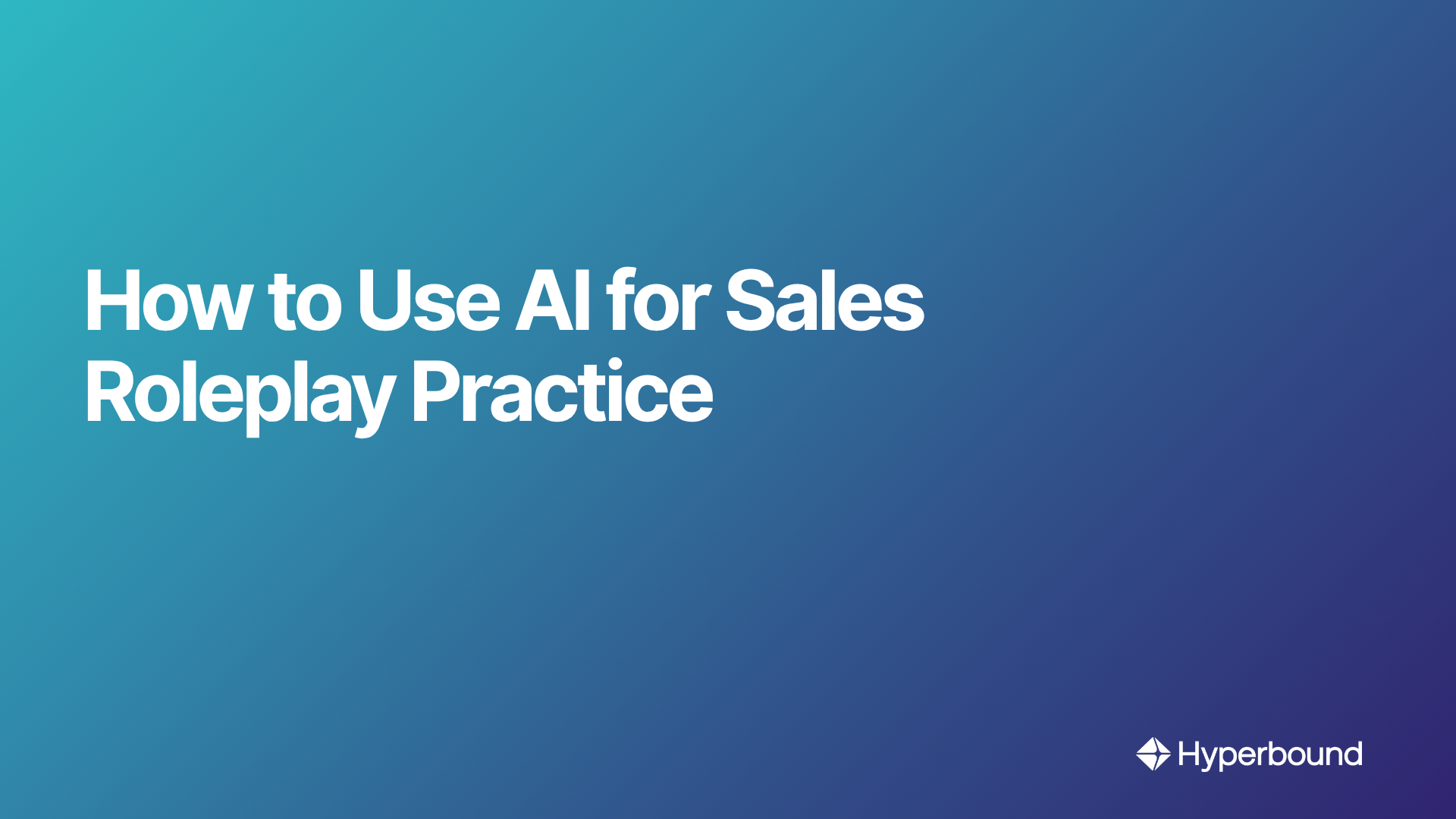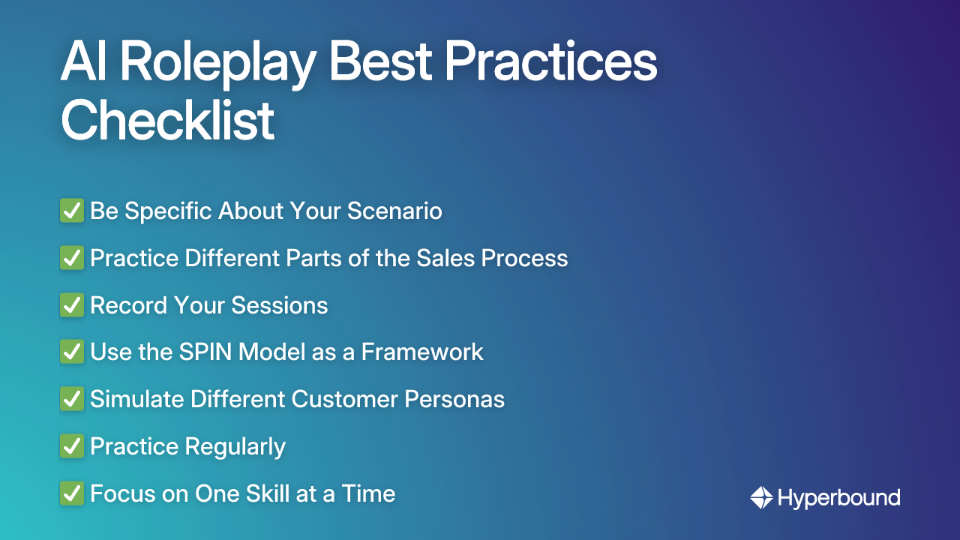
You've been there—about to enter a high-stakes sales call, your palms sweating as you rehearse your pitch for the tenth time. Or perhaps you're preparing for an interview where you'll need to "sell a luxury item on a cold call" and you're "not really sure where to even start on something like this."
Traditional sales roleplay has always been awkward. You're either practicing with a colleague who can't realistically simulate a skeptical executive decision maker, or you're flying solo, rehearsing in front of a mirror and imagining responses. Neither approach prepares you for the unpredictability of actual sales conversations.
Enter AI—your new 24/7, judgment-free practice partner.
As one sales professional put it, "ChatGPT has been a good friend of mine recently that has helped in many different situations." The beauty of AI for sales roleplay is that it provides a safe space to fail, experiment, and refine your approach before you're face-to-face with a real prospect.
In this guide, you'll learn exactly how to leverage AI tools to create realistic sales simulations, from basic free options to advanced platforms that can transform how your entire team practices and performs.
Why Traditional Role-Play is Broken (And How AI Fixes It)
Traditional sales roleplay suffers from several fundamental flaws:
- The Authenticity Gap: Colleagues playing "customer" rarely challenge you with realistic objections
- Performance Anxiety: Practicing in front of peers or managers creates unnecessary pressure
- Inconsistent Feedback: Different practice partners provide inconsistent, subjective feedback
- Limited Availability: Finding someone with time to help you practice is often impossible
AI roleplay solves these problems by providing:

- Realistic Scenarios: AI can simulate countless customer personas and objections
- Judgment-Free Practice: No audience means you can try new approaches without fear
- Immediate, Objective Feedback: Get consistent analysis of your performance
- 24/7 Availability: Practice whenever you have 15 minutes, not when someone else is free
Let's explore how to set this up, starting with the tools most accessible to individual reps.
Part 1: Your 24/7 Sales Coach - Getting Started with ChatGPT
Step 1: Set the Stage with a Master Prompt
The quality of your AI roleplay depends entirely on how well you set up the initial scenario. You need to be the director of this simulation.
Here's a master prompt template you can copy, paste, and customize:
You are an AI sales roleplay partner. I am a sales representative for [My Company Name], and my goal is to practice a [cold call/discovery call/objection handling scenario].
My Product/Service: [Describe your product, its features, and its core value. E.g., 'We provide a B2B SaaS platform that automates accounts receivable to reduce late payments.']
Your Persona: You are 'Sarah,' the CFO of a mid-sized manufacturing company. You are skeptical of new tech vendors due to a poor implementation experience with a previous provider. Your primary pain points are cash flow uncertainty and the high amount of manual work your finance team does. You are focused on ROI and implementation time.
The Scenario: This is a 15-minute simulated cold call. I will initiate the conversation. Please respond realistically as Sarah would. Be challenging but not impossible. Ask tough questions about price and integration. Do not break character unless I type 'PAUSE ROLEPLAY.' After we finish, I will ask for detailed feedback.
Pro Tip: Be specific about the pain points your AI persona should have. This allows you to practice identifying and addressing them using the SPIN model (Situation, Problem, Implication, Need-Payoff) during your conversation.
Step 2: Initiate the Roleplay (and Use the Voice Feature!)
Once you've set up your scenario, it's time to begin. For the most realistic practice, use the voice feature in the ChatGPT mobile app. This simulates the pressure of thinking on your feet without the luxury of typing and editing your responses.
Start your conversation naturally, as you would in a real call:
"Hi Sarah, this is [Your Name] from [Your Company]. I know I'm catching you out of the blue, so I'll be brief. We help finance teams like yours automate their accounts receivable processes to improve cash flow predictability. I'm curious what's going on that makes you think you should explore getting a new solution for your AR processes? Why now?"
Notice how this opening uses an open-ended question to uncover needs rather than launching into a pitch—a key technique for engaging executive decision makers.
Step 3: Guide the AI and Handle Objections
During your roleplay, you may want to steer the AI to present specific challenges or objections. You can do this without breaking the flow by using square brackets to insert directives:
[Stay in character, but now raise the objection that you're happy with your current vendor.]
This allows you to practice handling common objections like:
- "Your price is too high."
- "We're happy with our current vendor."
- "We don't have budget for this right now."
When addressing these objections, remember to validate the concern, ask clarifying questions to understand the underlying pain point, and then position your solution accordingly.
Step 4: Ask for Specific, Actionable Feedback
After completing your roleplay (by typing "PAUSE ROLEPLAY"), it's time to get feedback. Avoid generic questions like "How did I do?" Instead, ask for specific analysis:
- "Based on our conversation, what were my 3 biggest strengths and 3 biggest weaknesses?"
- "Critique my discovery questions. Did I successfully uncover your stated pain points? Which questions were most effective?"
- "Analyze my pitch against the SPIN model. Where did I succeed, and where did I fail to build the case before presenting the solution?"
This targeted feedback helps you identify specific areas for improvement in your next practice session.

Part 2: Leveling Up with Custom GPTs for Tailored Scenarios
While basic ChatGPT is powerful, you can save significant setup time by using Custom GPTs specifically designed for sales roleplay. As one sales professional noted, "I've actually created a custom chat gpt bot specifically for sales role play scenarios."
Custom GPTs are pre-configured versions of ChatGPT available in the GPT Store that come with built-in knowledge and instructions for specific tasks. This eliminates the need for extensive prompt engineering each time you want to practice.
Some effective sales-focused GPTs include:
- Sales Guru GPT: Enhances sales skills through roleplay and conversational techniques
- Negotiation Skills Coach for Salespeople: Simulates tough negotiation scenarios and provides feedback on your tactics
- Sales Objection Mentor: Helps you practice overcoming specific objections with multiple strategies
These tools provide a middle ground—more focused than standard ChatGPT, but they still lack the deep analytics, team scalability, and real-world data integration needed for professional sales organizations. For that, you need a dedicated platform.
Part 3: Mastering Your Craft with AI Sales Coaching Platforms
While ChatGPT and Custom GPTs are excellent for individual practice, they have limitations:
- Lack of Real-World Context: They haven't listened to your company's actual sales calls
- No Objective Scoring: Feedback can't be measured against a consistent methodology
- Not Scalable for Teams: They're tools for individuals, not platforms for managers to coach teams
This is where specialized platforms built for sales teams come in. Hyperbound, for example, is an AI Sales Coaching platform designed to overcome these limitations. Unlike generic AI tools, Hyperbound analyzes your team's actual winning sales calls to create hyper-realistic simulations and data-driven coaching.
A professional workflow with Hyperbound includes:
- Analyze Winning Behaviors: The platform uses AI Real Call Scoring to analyze your top performers' actual calls, identifying the talk tracks and techniques that close deals in your specific business context.
- Practice in Hyper-Realistic AI Roleplays: Sales reps can practice any scenario—from cold calls and discovery to demos and objection handling—with dynamic AI buyer personas based on real data. The AI Sales Roleplays feature supports diverse practice types across the entire sales cycle.
- Receive Instant, Objective Feedback: After each roleplay, reps get immediate, personalized feedback via AI Coaching. The platform's AI-Powered Scorecards measure performance against your company's specific sales methodology, tracking metrics like talk ratio, key selling moments, and how effectively objections were handled.
This approach is particularly valuable for:
- Reducing new hire ramp time by up to 50%
- Ensuring consistent messaging across the team
- Providing scalable coaching without burning out managers
- Creating tailored scenarios for specific customer types
For sales leaders focused on team performance improvement, platforms like Hyperbound offer a systematic approach to practice that goes beyond what individual AI tools can provide.
Pro-Tips for Any AI Roleplay Session (A Checklist)
Regardless of which AI tool you use, these best practices will maximize the value of your practice sessions:

✅ Be Specific About Your Scenario: The more details you provide about your product, customer, and situation, the more realistic the simulation will be.
✅ Practice Different Parts of the Sales Process: Don't just rehearse your pitch. Practice discovery questions, handling objections, and closing techniques separately.
✅ Record Your Sessions: Whether using voice or text, save your practice conversations to track improvement over time.
✅ Use the SPIN Model as a Framework: Structure your questions to uncover Situation, Problem, Implication, and Need-Payoff to create more compelling conversations.
✅ Simulate Different Customer Personas: Practice with various decision-maker types (technical, financial, operational) to prepare for any conversation.
✅ Practice Regularly: Even 15 minutes of AI roleplay practice daily can dramatically improve your skills and confidence.
✅ Focus on One Skill at a Time: Rather than trying to perfect everything at once, use each session to work on a specific skill (like active listening or handling price objections).
From Practice to Performance: Taking Action
The key to effective sales performance is consistent, realistic practice. AI tools have transformed what's possible, making high-quality practice accessible to everyone—from individual reps preparing for an interview to enterprise sales teams scaling their coaching efforts.
You can start today with free tools like ChatGPT, level up with Custom GPTs for more focused practice, and for organizations serious about sales excellence, platforms like Hyperbound provide data-driven, scalable coaching that transforms team performance.
Stop practicing on live prospects. Choose the tool that fits your current needs, pick your toughest scenario, fire up your AI coach, and start building the skills that close deals. Your future self—and your quota—will thank you.
Remember, as one sales professional put it, hiring managers are looking for people who are "coachable" and can "take control of the situation." Regular practice with AI tools demonstrates both qualities, giving you the confidence to excel in any sales conversation.
Whether you're preparing for your next big enterprise pitch or a simulated cold call in a a job interview, AI roleplay provides the safe, effective practice environment you need to master your craft.
Frequently Asked Questions About AI Sales Roleplay
What is AI sales roleplay?
AI sales roleplay is a training method where sales professionals practice conversations with an AI-powered bot that simulates a customer persona. It provides a safe, judgment-free environment to rehearse various sales scenarios, from cold calls to objection handling, without the pressure of practicing with colleagues or live prospects. The AI can be configured to represent specific customer types with unique pain points and objections, offering a realistic and repeatable practice experience.
How can I start using AI for sales roleplay for free?
You can start using AI for sales roleplay for free with accessible tools like ChatGPT. By providing a detailed "master prompt" that sets the stage—describing your product, the customer persona, and the scenario—you can turn ChatGPT into a 24/7 practice partner. For a more realistic experience, use the voice feature on the mobile app to simulate a real phone call.
Why is AI roleplay more effective than traditional methods?
AI roleplay is more effective than traditional methods because it overcomes key issues like the authenticity gap, performance anxiety, and inconsistent feedback. Unlike practicing with colleagues who may struggle to realistically simulate a skeptical buyer, AI can embody countless personas and scenarios. It offers a judgment-free zone for experimentation, provides immediate and objective feedback, and is available 24/7 for practice whenever you need it.
What kind of sales scenarios can I practice with AI?
You can practice virtually any part of the sales cycle with AI. This includes initial cold calls, discovery sessions to uncover customer needs using frameworks like SPIN, product demos, handling specific objections (e.g., price, budget, satisfaction with a current vendor), and even complex negotiation scenarios. Advanced platforms allow for highly tailored scenarios based on your company's real sales data.
What is the difference between using ChatGPT and a specialized AI sales coaching platform?
The main difference is that ChatGPT is a general-purpose tool for individual practice, while a specialized platform like Hyperbound is a comprehensive coaching solution for sales teams that is built on real-world sales data. ChatGPT requires you to manually create scenarios each time. In contrast, specialized platforms analyze your team's actual winning calls to create hyper-realistic simulations, provide objective scoring against a consistent sales methodology, and offer scalable coaching tools for managers.
How can I ensure the AI simulation is realistic?
To ensure a realistic AI simulation, you must provide a highly specific and detailed initial prompt. The more detail you include about your product, its value proposition, the target customer's persona (their role, goals, and specific pain points), and the context of the conversation, the more accurately the AI can simulate the interaction. This includes telling the AI to be skeptical or to raise certain objections during the roleplay.

Book a demo with Hyperbound
.png)













